 |
|
Lighting designer Barbara Horton. (Photo Credit: Philips) |
Creating Magical Experiences Through Light
Barbara Horton’s infectious enthusiasm for lighting design was apparent as we sat down for a candid discussion about her experiences throughout her career. Over the last 30+ years Barbara has compiled a portfolio of notable projects and is known for her expertise in designing urban lighting for parks, streetscapes and monuments. Combining her passion for lighting with her inquisitive nature and visionary perspective, she uses a pragmatic approach to develop unique solutions for each project she takes on. As the President/CEO of Horton Lees Brogden Lighting Design in New York City, as well as the current President of the International Association of Lighting Designers (IALD), Barbara is focused on giving back and improving the industry for future generations of lighting designers.
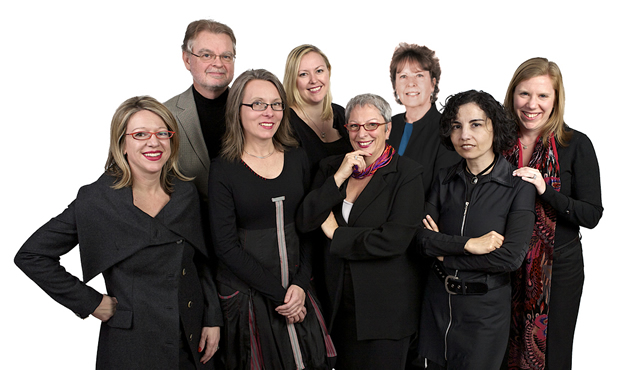 |
|
(Photo Credit: Philips) |
What makes you passionate about lighting design?
Lighting is a unique medium that has a magical power. It allows us to transform our environments and create new experiences for people. Every job is different and there’s no cookie cutter solution. We’re in an era where technology is leap-frogging, so we’re constantly learning. You can’t just pick an LED off of a piece of paper – you need to eat, breathe and sleep the products, and that’s exciting! We’re living in an evolving environment with constant new ideas, materials and sources of light that keep my interest and education going. It’s stimulating to have new tools that allow us to apply things in innovative ways.
How do you use light to transform spaces?
Understanding how light impacts the end user is the tool we use to create lighting that transforms the space. Each time we take on a new project, regardless of the type, we need to spend time with the client to understand the program – what are the ultimate goals they are trying to accomplish – and then we define that in light. These are really collaborative conversations that look at how light can enhance experiences and the most important thing is the visual assessment – looking at the materials, playing with textures, mocking something up and testing – to determine where the light could be and how they want to see it. These are the things that engage the client in the decision making process and helps you understand what the “magic of light” can be.
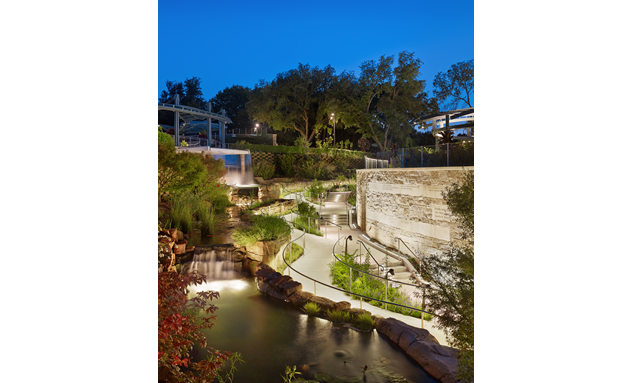 |
|
Rory Meyers Chrildren’s Adventure Garden Discovery Center, Dallas TX (Photo Credit: Casey Dunn) |
The “magic of light” is something you feel, rather than a visual thing. You step into an environment and somehow you are transformed in a subliminal way that creates a magical experience, which you may not even be aware of. That is what lighting is all about – creating a psychological environment or emotion that can do many things. I like the idea that lighting becomes experiential, and that to me is the magic!
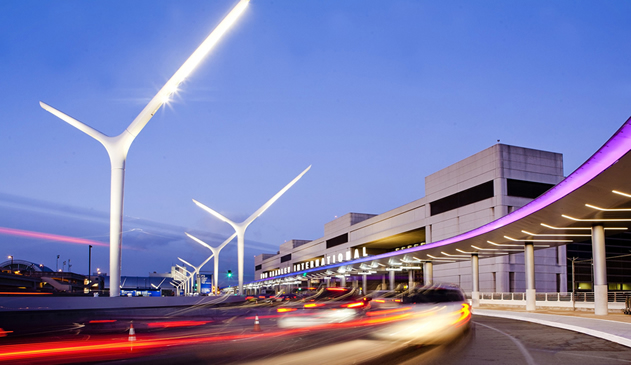 |
|
Los Angeles International Airport, CTA Curbside (Photo Credit: AECOM) |
What would you like to accomplish as the President of the International Association of Lighting Designers (IALD)?
I thought about this four years ago when I was serving on the board, well before I was selected as president. I would say that in this period of time, and now seeing it come to fruition several years later, the most important thing for me to follow through with during my presidency would be the credentialing for lighting designers worldwide. Approximately three years ago the IALD, along with a number of other organizations, threw the gauntlet down and decided to create something. To begin the process, we hired a professional psychometric consultant who helps organizations develop credentialing.
We formed a very large task force of 30 people fromvarious parts of the industry, including IES*, PLDA* andNCQLP*, to determine what we needed. Over the last three years this evolved into a smaller task force that focused on the feedback we received from people outside of the IALD. Based on results from questionnaires and an alpha-beta test, it’s apparent that this has value and is something that we can’t afford not to do! We are also partnering with other organizations in the Architecture, Engineering and Construction (AEC) industry around the world, such as the AIA*, ASID* and ASBAI*, which have had a voice in our conversations on what this is about and why it’s necessary. The impact of the credentialing will be to raise the bar for what we – as lighting designers around the world – need to have in our toolkit, as well as the design excellence that we bring to the table.* Illuminating Engineering Society (IES); The Professional Lighting Designers’ Association (PLDA); National Council on Qualifications for the Lighting Professions (NCQLP); The American Institute of Architects (AIA); The American Society of Interior Designers (ASID);Brazilian Association of Allergy and Immunology (ASBAI).
What are the IALD’s short- and long-term goals?
An important goal of mine is membership outreach. I see the benefit of me, or any president of IALD, engaging with people outside of our everyday life – they get to know a person and see the IALD as a community, and not just an organization. Suddenly you find camaraderie and realize that you’re all in the same situation and have the same issues. Having the opportunity to connect with people is really important! Another one of my short-term goals has to do with the implementation of credentialing. I am hoping that by the first quarter in 2015 we will have recognition from authorities around the world, whether it’s the governing body or on the utilities side. Once the credentialing is in place we will need to do some training to make sure that our next generation is well-served by this process. Lighting is very complex and there are a lot of challenges that you need to be trained to address – from energy conservation to health and wellness to the psychology of light.
Based on the IALD’s strategic plan, one of the long-term goals focuses on expansion – outreach to chapters in different regions to make sure we have the networks, educational programs and connectivity amongst lighting designers. The industry is constantly changing so we need to have open dialog and get feedback in order to keep up with everything that is happening. The IALD has a very similar model to the IES, except we don’t have governing bodies in each of the locations. We recognize that we need someone who can be on the ground in various locations to facilitate communication so, although our central staff is in Chicago, we have other staff members in the UK, Japan, and we’re currently working on having someone in Europe by the end of this year.
What trends do you see in buildings and/or design impacting lighting?
The biggest trend I see in buildings is that the design software has transformed what the shapes of buildings can be and the available materials are being explored in completely different ways. Architects gravitate towards the coolest technologies, so this is definitely a big change in the built environment. The impact of that on lighting is that we are in an era where technology, especially LED, is constantly advancing on a continuous basis. This provides tremendous inspiration because every time I’m challenged by a new material, physical height, shape or technique that an architect wants to explore, we’re now saying that we think we can do it and want to try it – whereas with traditional sources we weren’t able to play in that arena. Lighting designers are now faced with the interesting challenge of incorporating all their expertise with the technology that’s out there in a way that they end up with an innovative, successful project. The world’s sensibility about shapes, materials, and light integration is transforming, and this will be the excitement for the future!
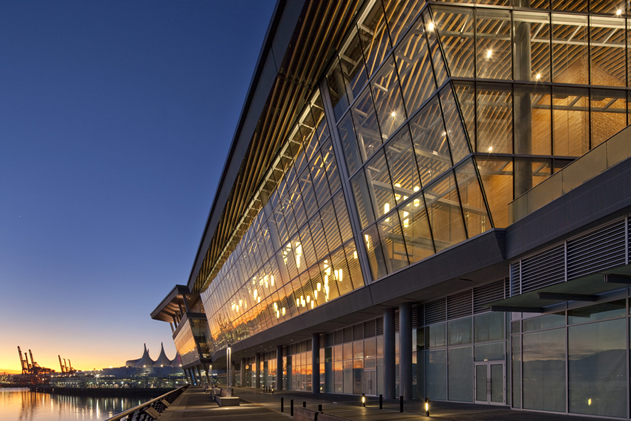 |
|
Vancouver Convention Center, Vancouver, BC (Photo Credit: Bob Matheson) |
What are some important things you have learned through your experiences that can help others in the industry?
The things I’ve learned are not so much about the design side, but rather about running a business. As I took over as president of my firm I started to learn that you can’t do it all by yourself. We have amazing people on our team and are very fortunate to have eight principals in our firm—owners in the company who are running four offices, very successfully. The most important thing I’ve learned is to let go, give people opportunities, and make sure you’re a good mentor.
Is there any project that stands out as being your favorite or the most memorable?
The World War II Memorial in Washington, DC is really special to me and I was very glad to be a part of it. Learning about the history and observing people who had served when they were 16 years old come to the commemoration made quite a compelling story and was an amazing experience. As part of the process, not only did we have to read and understand the history, but we had to work with the artists carving the spectacularwalls to know what content they would be using to commemorate what this war was about. I have a great deal of pride in what happened throughout that process and how it evolved into something magical where people interact with the light as they walk through the rampart walls and read the commemorative information – they’re engaged in that experience and light is a part of it.
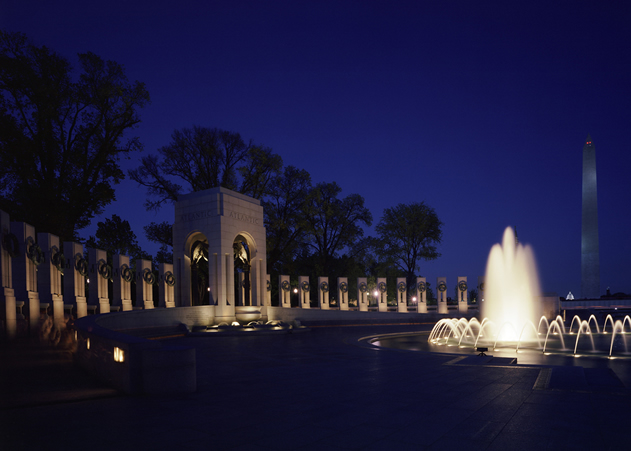 |
|
World War II Memorial, Washington, DC (Photo Credit: Brett Drury Architectural Photography) |
One of the most exciting things about this project was working with a group of seven people who were all WWII veterans and had joined the army as volunteers. The project was politically challenging, due to high visibility with the public, and went through a lot of scrutiny. Lighting was always a part of that and not an after-thought; we had to consider what the experience would be like during the day, and what it would be like at night.
There were also some environmental challenges we had to consider, and program challenges with what the client wanted to achieve with the memorial in the end. In addition, there were several technical challenges in the placement of fixtures into the architectural forms, so we had to work closely with the manufacturers to ensure longevity and the transcendence of time. Overcoming all these challenges made it a crowning moment when it finally opened, and I felt very proud to be one of the people influencing our capital.
Looking back at your career, what is your favorite part of being a lighting designer, business owner, and volunteer?
My favorite part of being a lighting designer is having the opportunity to create special environments or experiences for people. As a business owner, I’ve enjoyed the challenges of how business evolves and developing the core group of people that help define our culture and keep us moving forward operationally.
It’s been very rewarding to see that evolution. On the volunteer side, I’ve learned that you give a little and you get a lot back through camaraderie with peers. Being part of the IALD and the IES has given me some career building skills and a sense of confidence in myself. It’s important to be a volunteer in any industry organization because it’s not just about paying your dues and getting a membership card, it’s about participating!
TAGS:

















